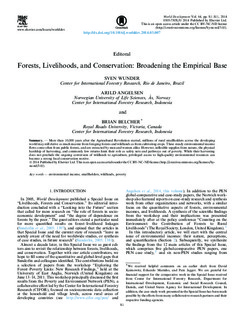| dc.contributor.author | Wunder, Sven | |
| dc.contributor.author | Angelsen, Arild | |
| dc.contributor.author | Belcher, Brian | |
| dc.date.accessioned | 2015-02-05T09:43:49Z | |
| dc.date.accessioned | 2015-04-28T06:28:08Z | |
| dc.date.available | 2015-02-05T09:43:49Z | |
| dc.date.available | 2015-04-28T06:28:08Z | |
| dc.date.issued | 2014 | |
| dc.identifier.citation | World Development 2014, 64:S1-S11 | nb_NO |
| dc.identifier.issn | 0305-750X | |
| dc.identifier.uri | http://hdl.handle.net/11250/282583 | |
| dc.description | - | nb_NO |
| dc.description.abstract | More than 10,000 years after the Agricultural Revolution started, millions of rural smallholders across the developing world may still derive as much income from foraging forests and wildlands as from cultivating crops. These steady environmental income flows come often from public forests, and are extracted by men and women alike. However, inflexible supplies from nature, the physical hardship of harvesting, and commonly low returns limit their role as safety nets and pathways out of poverty. While their harvesting does not preclude the ongoing conversion of wildlands to agriculture, privileged access to high-quality environmental resources can become a strong local conservation motive. | nb_NO |
| dc.language.iso | eng | nb_NO |
| dc.rights | Navngivelse-Ikkekommersiell-IngenBearbeidelse 3.0 Norge | * |
| dc.rights.uri | http://creativecommons.org/licenses/by-nc-nd/3.0/no/ | * |
| dc.title | Forests, livelihoods, and conservation: broadening the empirical base | nb_NO |
| dc.type | Journal article | nb_NO |
| dc.type | Peer reviewed | nb_NO |
| dc.date.updated | 2015-02-05T09:43:49Z | |
| dc.identifier.doi | 10.1016/j.worlddev.2014.03.007 | |
| dc.identifier.cristin | 1217338 | |

